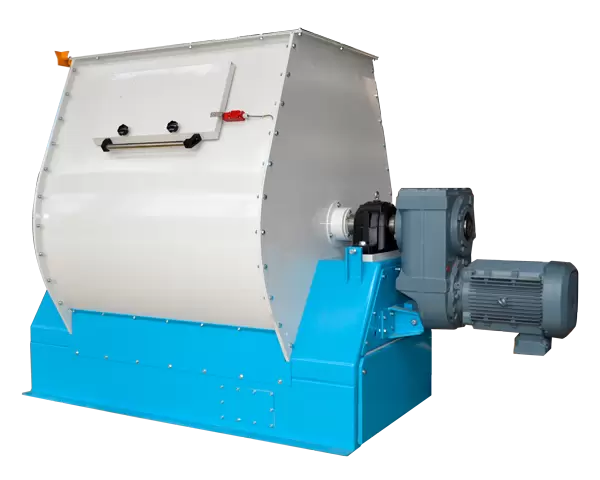In the modern breeding industry, uniform mixing of feed is essential for the healthy growth of livestock and poultry. Horizontal feed mixers have become the preferred equipment for many farmers and feed processing companies because of their uniform mixing, simple operation and high efficiency. The prices of horizontal feed mixers on the market vary greatly. So, what factors determine the price of horizontal feed mixers? How to choose a cost-effective feed mixers? This article will reveal the secrets for you and help you make wise purchasing decisions.
The capacity of a horizontal feed mixer is one of the core factors that determine the price. The capacity of equipment currently on the market ranges from 500kg to 5000kg. The larger the capacity, the higher the price. In addition, large-capacity equipment is usually equipped with more complex mixing systems and control systems to ensure uniform mixing of feed.

The material of a horizontal feed mixer also has an important impact on its price. Common materials include carbon steel, stainless steel and alloy steel. The choice of different materials directly determines the durability, corrosion resistance and cleaning convenience of the mixer.
Carbon steel: relatively low price, but poor corrosion resistance. Suitable for feed materials that are not susceptible to corrosion. The service life is relatively short, and regular maintenance or replacement of parts is usually required.
Stainless steel: Due to its excellent corrosion resistance and strong oxidation resistance, stainless steel horizontal mixers are more expensive and are suitable for feeds with high water content or easy to corrode, such as wet feed, silage, etc. The material of stainless steel enables the equipment to withstand long-term use and is easy to clean, so it has been widely used in most large-scale livestock.
Alloy steel: This material is usually used to make high-load mixers, with higher wear resistance and fatigue resistance, suitable for occasions requiring high-intensity mixing, but its price is also more expensive.
The mixing method of the horizontal feed mixer directly determines its mixing efficiency and effect. The common mixing methods on the market are mainly the following:
single-shaft mixing: This is a common mixing method with a relatively low price. The advantages of a single-axis mixer are simple structure and easy operation, which is suitable for situations where the mixed materials are relatively single. The disadvantage is uneven mixing, especially when the feed types are more complex, the effect may not be satisfactory.
double-shaft mixing: Double-axis mixers have higher mixing efficiency and uniformity, and are suitable for more complex material mixing. The mixing effect of the double-shaft mixer is better than that of the single-shaft mixer, so the price is relatively high.
Multi-shaft mixing: For mixing tasks that require higher efficiency and higher uniformity, some premium horizontal feed mixers are equipped with multiple mixing shafts. This equipment is generally used in large farms or feed processing plants that have extremely high requirements for mixing quality, and the price is usually higher.
With the development of technology, more and more horizontal feed mixers have begun to adopt automatic control systems. The level of automation directly affects the price of the equipment.
Basic mixer: This type of equipment is relatively simple to operate and is usually controlled manually or semi-automatically. The price is relatively cheap and is suitable for small farms or occasions where automation requirements are not high.
Automated control mixer: A mixer with a high degree of automation is equipped with an intelligent control system that can automatically adjust parameters such as mixing time and speed, and can even be linked with other equipment (such as feed formulation systems). Through automated operation, not only production efficiency is improved, but also labor costs are reduced. Because it is equipped with a high-end control system, the price of this type of equipment is usually higher.
Intelligent feed mixer: In some modern breeding enterprises, intelligent mixers have gradually been used. These devices usually have functions such as data collection and remote monitoring, and can realize remote operation and maintenance. The price of this type of equipment is relatively high, but for large-scale breeding enterprises, it provides higher efficiency and management convenience.
Brand is one of the important factors affecting the price of horizontal feed mixers. Equipment from well-known brands is usually more expensive, but its quality and after-sales service are also more guaranteed. Choosing equipment from big brands can not only ensure the quality and stability of the equipment, but also enjoy perfect after-sales service. When choosing a horizontal feed mixer, in addition to paying attention to the price, it is also necessary to comprehensively consider the quality of after-sales service. Better after-sales service can not only ensure the normal operation of the equipment, but also extend the service life of the equipment and reduce the cost of later maintenance.
Some equipment may be equipped with liquid addition system, automatic cleaning function, dust prevention device, etc. These additional functions will also increase the cost of the equipment.
In general, the price of horizontal feed mixers is affected by many factors, including the capacity, material, mixing method, degree of automation, brand and after-sales service of the equipment. When buying horizontal feed mixers, consumers should consider these factors comprehensively according to their own breeding scale, budget and technical requirements, so as to make a wise decision. Through reasonable selection, we can not only obtain cost-effective equipment, but also improve breeding efficiency, ensure the quality of feed mixing, and promote the sustainable development of the breeding industry.